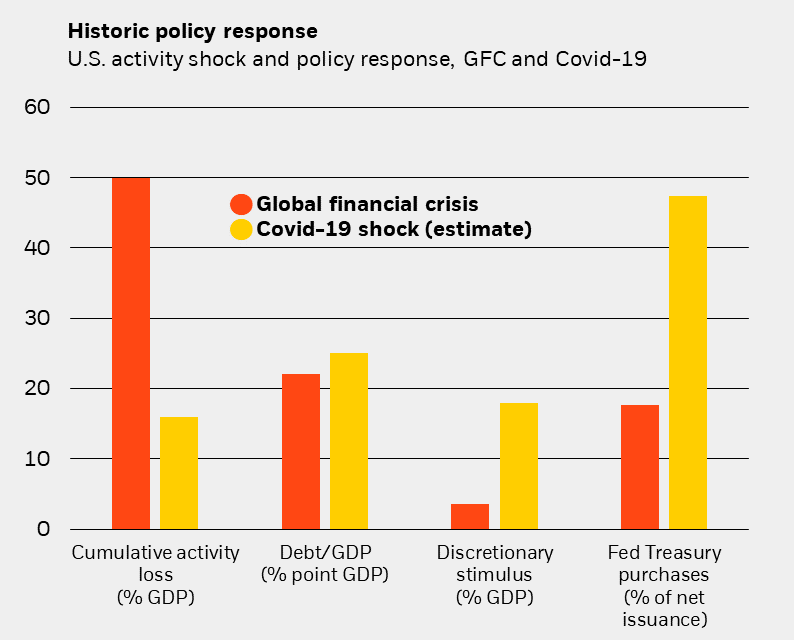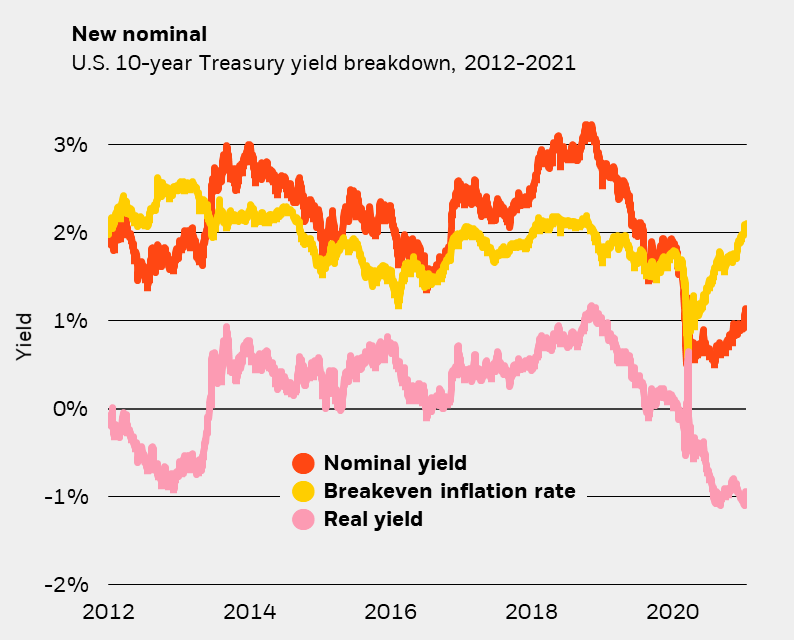A fundamental rethink

We have entered a new investment order. The Covid-19 pandemic has accelerated profound shifts in how economies and societies operate across four dimensions: sustainability, inequality, geopolitics and macro policy.
We believe this calls for a fundamental rethink of investment portfolios – starting now. The BlackRock Investment Institute, under the leadership of Jean Boivin, presents a sample of its insights as global leaders share their views on the state of the world through the digital “Davos Dialogues.”
Inflation jitters
We have been flagging higher inflation since the unprecedented policy response to the pandemic, and this prospect is now driving markets. Our core new nominal theme implies that rising inflation will have more benign market implications than in the past. Central banks are likely to lean against any sharp rises in nominal government bond yields. As a result, real interest rates could stay negative into the medium term. This makes for a positive backdrop for risk assets, and keeps us pro risk with tactical overweights in equities and credit. Yet markets have risen significantly, and we see potential for pullbacks driven by pandemic and vaccine rollout dynamics.
Globalization rewired
The pandemic has accelerated a rewiring of globalization – with a bipolar U.S.-China world order at its center. We see the new U.S. administration bringing greater predictability in trade policies. Climate is likely to become a central policy priority – and an area for potential U.S.-China cooperation. Yet economic, technological and strategic competition with China looks here to stay – and we believe investors need exposures to both poles of global growth.
Rising debt
A spike in government debt to record levels – a result of a policy revolution in cooperation between fiscal and monetary authorities – was a necessary response to the Covid shock. It may be politically tough for governments to unwind large-scale fiscal support, and the perceived safety premium for holding government bonds could eventually erode. But we are not concerned about these dynamics in the near term as central banks face pressures to maintain a stable, low-rate environment, keeping a lid on debt servicing costs.
Unprecedented response
The joint fiscal-monetary policy revolution has delivered historic support to help bridge economies to a post-pandemic world when vaccines become more widely available. We have seen an unprecedented rise in peacetime spending, with discretionary fiscal stimulus far exceeding what we saw after the global financial crisis (GFC). The increase in debt under the current shock also exceeds that of the GFC, even in the absence of large-scale bailouts this time. This has happened against a backdrop of much higher debt levels than a decade ago. As a result, debt-to-GDP ratios have soared to record levels globally.
New tolerance levels

Sources: BlackRock Investment Institute and International Monetary Fund, with data from Haver Analytics, January 2021. Notes: The chart shows the debt-to-GDP ratios of major economies over the past century.
Attitudes toward higher debt levels are more relaxed today. Historically low and negative interest rates are part of the reason why – and have reduced debt financing burdens. Low rates provide extra fiscal space that should be utilized, in our view.
Yet even if interest rates stay low – and below the rate of GDP growth – there are still limits to how high debt can go before investors start demanding additional compensation for holding government bonds. Structural forces such as ample global savings are likely to keep rates low, but we could see a change in the premium for the perceived safety of holding government debt – with major market implications.
The role of bonds

Sources: BlackRock Investment Institute, with data from Refinitiv Datastream and Haver Analytics, January 2021. Notes: The chart shows our estimate of the eventual cumulative GDP loss from the GFC (2008-2009) and our expectation for the Covid-19 shock (2020-2021) as well as various measures of the policy response: the two-year increase in debt-to-GDP, discretionary fiscal stimulus and Federal Reserve purchases of U.S. Treasuries as a share of net issuance (new issues minus maturing bonds). The cumulative loss measures the estimated difference between nominal GDP at the time and where it would have been if it had continued to grow at the pre-crisis trend level.
The March 2020 dislocations in the U.S. Treasuries market showed that they didn’t prove as effective a hedge against riskoff markets as in the past (until the Fed intervened). This underscores the challenged role of government bonds from yields near their effective lower bounds and the risk of higher inflation.
Also, some countries are likely to test their fiscal space with the surge in debt since the Covid-19 shock.
For these reasons, the safety premium could flip to a risk premium over time – and test central banks’ comfort with higher long-term rates.
Key risks ahead
Fiscal and financial dominance are key risks that could be mutually reinforcing. It could become politically difficult for governments to unwind large-scale fiscal support. And raising interest rates will become more politically fraught for central banks against a backdrop of high debt levels. Even a courageous central bank may end up having to backtrack if an attempt to normalize policy were to result in a “taper tantrum” event that significantly tightened financial conditions.
A bipolar world order
The pandemic has accelerated a rewiring of globalization – with a bipolar U.S.-China world order at its center. We see the Biden administration as bringing greater predictability and taking a different approach on trade and climate policy. Yet overall tensions with China appear set to stay elevated amid ongoing economic, technological and strategic competition – and we believe investors need exposures to both poles of global growth.
Globalization rewired, one of the three key investment themes introduced in our 2021 Global Outlook, is about an acceleration of geopolitical transformations. At its center: a bi-polar U.S.-China world order and the remapping of global supply chains. This is not the same as deglobalization.
Globalization rewired

Sources: BlackRock Investment Institute and the International Monetary Fund (IMF), with data from Haver Analytics, December 2020. Note: The orange line shows China’s annual real GDP growth rate. The dotted lines are IMF forecasts. The yellow bars show China’s past and expected share of global GDP. There is no guarantee any forecasts made will come to pass.
China is opening its capital markets to global investors, and still attracting foreign investment. China’s share of global GDP is approaching 20% - more than four times its weight in 2000 – even as its growth rate has slowed over time. See the chart. China’s growth has returned to the pre-pandemic trend, leading other major economies in recovering from the Covid shock.
China new five-year plan looks set to include a greater focus on developing key technologies, pursuing net-zero carbon emissions and allowing greater market pricing of credit risk. Against this backdrop we expect U.S.-China relations to continue to be marked by intense rivalry, particularly in technology, as both countries seek self-sufficiency in critical industries.
Clear changes ahead
We expect a clear change of tenor and tone in the Biden administration’s foreign policy approach, including a shift to working with allies on key issues: China, Russia, Iran, democracy and cyber security. The Biden administration will likely use alliances with groups of countries to engage China. The nomination of veteran Asia specialist Kurt Campbell to serve the new role of Indo-Pacific Coordinator is a signal of such an approach – as well as the administration’s expectation that intense competition is likely to dominate U.S.-China relations. This is taking place as China has emerged stronger from 2020 with its successful containment of the virus and a lead in the economic restart. It has also signed important trade deals including an investment agreement with the European Union, and a regional free trade agreement with Asia-Pacific nations including Japan and South Korea.
Climate action
Climate is likely to become a central policy priority under the Biden administration – and an area for potential cooperation in U.S.-China relations amid broader tensions around trade and human rights. Frictions may extend to the financial arena, as evidenced in the forced delisting of some Chinese companies in the U.S. market. We see this as a reason for carefully implementing China exposures, perhaps including consideration of greater direct allocations to China-listed securities over time. Yet how to implement China exposures will depend on investor constraints, including political and legal ones.
Portfolio insights
Strategically, we see assets exposed to Chinese growth as core holdings that are distinct from emerging market exposures. Tactically, we are overweight Asia ex-Japan equities as many Asian countries have been more effective at containing the virus and are further ahead in the economic restart. Risks to China-exposed assets include China’s high debt levels, currency volatility and heightened U.S.-China conflicts. But we believe investors are well compensated for these.
BlackRock’s 2021 investment themes
The new nominal
We see stronger growth and lower real yields as the vaccine-led restart accelerates and central banks limit nominal yields gains even as inflation expectations climb. Inflation will likely have different implications to the past.
Strategic implication: We are underweight government bonds and see equities supported by falling real rates.
Tactical implication: Our low rate outlook keeps us pro-risk. We like U.S. equities and prefer high yield for income.
A bar-belled approach

Source: BlackRock Investment Institute and Refinitiv Datastream, data as of 12 January 2021. Notes: The chart shows the U.S. 10-year Treasury yield and the pricing of Treasury inflation protected securities – the 10-year TIPS yield, or real yield, and the breakeven inflation rate, or the future rate of inflation being priced by markets in TIPS. Past performance is not a reliable indicator of current or future results.
The Democrats’ newly gained majority in U.S. Congress paves the way for greater public spending but the narrow margin limits the scope for higher taxes, in our view. Coupled with the prospect of a strong vaccine-led economic restart in the second half, we expect a speeding up of “the new nominal”, or our expectations for stronger growth with stable nominal yields.
U.S. Treasury yields recently breached 1% for the first time since last March, driven by increases in both inflation expectations and real yields, as the chart shows. This suggests markets are likely to test the Fed’s resolve to lean against any excessive climb in nominal yields.
The first half of 2021 is likely to be choppy. The pandemic challenges public health and the activity restart, while we see more policy support in the U.S. on top of the recent $900 billion fiscal package. We prefer a barbell approach to risk exposures, with selected cyclicals such as U.S. small-caps and emerging market equities on one end and quality assets including U.S. and Asia ex-Japan equities on the other. We also like tech and healthcare. These sectors can benefit from structural trends turbocharged by the pandemic, in our view, and their strong balance sheets and cash flows help provide some resilience against volatility. Yet we recognize U.S. tech could face challenges from greater regulation and corporate taxes.
We remain pro-risk overall, favoring overweights in both equities and credit, but see a potentially bumpy path for asset prices broadly, especially as markets have moved a lot since we published our 2021 global outlook in early December.
Globalization rewired
Covid-19 has accelerated geopolitical transformations such as a bipolar U.S.-China world order and a remaking of global supply chains, placing greater weight on resilience – even at the expense of efficiency.
Strategic implication: We favor deliberate country diversification and above-benchmark China exposures.
Tactical implication: We like EM equities, especially Asia ex-Japan, and are underweight Europe and Japan.
Turbocharged transformations
The pandemic has added fuel to pre-existing structural trends such as an increased focus on sustainability, rising inequality within and across nations, and the dominance of e-commerce at the expense of traditional retail.
Strategic implication: We prefer sustainable assets amid a growing societal preference for sustainability.
Tactical implication: We take a barbell approach, favoring tech and healthcare as well as selected cyclical exposures.




